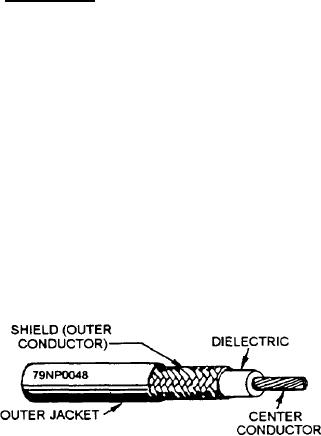
Repeated flexing service cable designed for general
classified according to its application and is of two
use is of four different types, depending on the number
types--general use and special use.
of conductors. This type cable is available in various
GENERAL USE.-- Nonflexing service cable can
conductor sizes and designated:
be used in nearly all parts of electric distribution
LSSHOF (single conductor)
systems, including the common telephone circuits and
most propulsion circuits. Special cases occur in dc
LSDHOF (two conductor)
propulsion circuits for surface ships. In those cases
LSTHOF (three conductor)
where the impressed voltage is less than 1,000 volts, an
exception is permitted.
LSFHOF (four conductor)
LSDSGA (low-smoke, two-conductor, silicone
SPECIAL USE.-- There are many different types
rubber and glass-braided insulation, cross-linked
of flexing service cable designed for special
polyolefin jacket, armored)is one type of cable usually
requirements of certain installations, including those
used in communications lines (LSTTOP) and casualty
found in this general use, nonflexing service. Also in this
power cables (LSTHOF). TRF cable is used for
classification is LSMSCA (low-smoke, multiconductor,
arc-welding circuits.
silicone rubber insulated-glass braided conductors,
cross-linked polyolefin jacket, armored). This cable is
RADIO-FREQUENCY COAXIAL CABLES
nothing more than watertight cable used in interior
communications, as well as in fire control circuits.
Radio-frequency (RF) cables may look like power
cables, but they require special handling and careful
SPECIAL USE.-- There are many shipboard
installation. RF cables are vital to the proper operation
electrical circuits that have special requirements for
of all electronic equipment. They must be installed and
voltage, current, frequency, and service. These
maintained with the greatest care. The following is an
requirements must be met in cable installation. There
example of a common RF cable having the properties
are also other circuits where general-use, nonflexing
shown below:
service cable may meet the necessary requirements but
LSTTRSU/A The following is an example of the
be economical y impracticable. For these reasons, there
properties of a common radio-frequency cable:
are many different types of nonflexing service cable for
specialized use, such as degaussing, telephone, radio,
LS -- Low smoke
and casualty power. For example, LSMDU cable is a
TT -- Twisted pairs
multiconductor cable used in degaussing circuits.
R -- Radio
LSTCJA cable consists of one conductor of constantan
(red) and one conductor of iron (gray), and is used for
S
-- Shielded flexible, cross-linked polyethylene
pyrometer base leads.
insulation, braided shield for each pair, cross-
linked polyolefin jacket
Flexing Service Cable
U -- Unarmored
A -- Armored
Flexing service cable designed for use aboard ship
Flexible RF transmission lines (coax) are
is commonly referred to as being portable. It is
two-conductor cables. One conductor is concentrically
principally used as leads to portable electric equipment.
contained within the other as shown in figure 2-2. Both
There are two types of flexing service cable--general
use and special use.
GENERAL USE.-- Repeated flexing service cable
is used as leads to portable electric equipment and
permanently installed equipment in places where cables
are subjected to repeated bending, twisting, mechanical
abrasion, oil, sunlight, or where maximum resistance to
moisture is required. Its letter designation is LSHOF
Figure 2-2--Construction of flexible RF transmission line.
(low smoke, heat and oil resistant, flexible).
2-5

